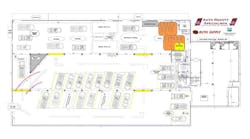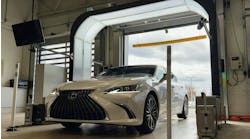Over the last century, the world has become ever more mechanized. This mechanized world is one that incorporates machines that allow power and work to be done. For power or energy to transfer from one component to another, rotational movement is incorporated. With this power movement from one source to another, comes vibration and sound.
Vibration, harshness, sound and noise
Vibration and sound are the same in that they are both frequencies. When we consider vibration, it is a frequency that is moving through a mechanical means that produces mechanical force. When we consider sound, it is a vibrating frequency that is moving through air or another medium and can be heard when it reaches a person’s ear or a sensing device (such as a microphone).
All power or energy transmission through mechanical means produces vibration and sound. This fundamental principle will be important when dealing with vehicle vibration and sound issues. Now that we have established that all vehicles will produce vibration and sound, it is imperative to understand the difference between vibration and harshness, and the difference between sound and noise.
Noise, vibration and harshness (NVH) has become an ever-increasing problem for engineering teams on modern vehicles. The modern vehicle is designed and engineered to reduce vibration and sound within the vehicle. Therefore, any additional vibration and or noise is much easier for the vehicle occupants to recognize.
The modern vehicle comes in many sizes and weight categories. Therefore, the vibration and noise from each vehicle will be different. For example, a luxury sedan’s vibration and/or noise concern would be much less than a 1-ton truck’s vibration and/or noise concern. Each vehicle has a different design target for what vibration and noise level is acceptable. So first, one needs to know what is normal for the vehicle that is being diagnosed. That being said, most vehicles that are brought to you to diagnose have a definite vibration and/or noise issue.
It has long been known that rotating components can produce unwanted vibrations. When these vibrations are produced by components within a vehicle it can be very difficult to determine where the vibrations are emanating from. Vehicles contain many rotating components: tires, wheels, hubs, rotors, drums, axle shafts, driveshafts, transmissions, differentials, pumps, generators and engines, just to name a few. These components are balanced to assure that they will not create vibrations. However, from either imbalance, wear or poor design, vibrations can (and will) be present in vehicles. The question is how to locate the cause of the issue.
The scientific approach to vibration analysis
Perhaps the best method to locate these vibrations is to have an in-depth understanding of how these vibrations and/or noise issues are produced. To understand this, we need to understand what components on the vehicle are in rotation and the speed they are rotating at. So first let’s take a look at the tire/wheel rotational speed. Tires have their size coded into the tire sidewall. For example, for a tire that is labeled as a 285/75R16 is 285 millimeters wide, 213.75 mm high (75 percent of its width) and is designed for a 16 inch rim. The circumference of this tire will need to be calculated to know the tire’s rotational speed. The equations to calculate this are shown, but please don’t get caught up in the math; just get the idea (Figure 1).
With the tire circumference known, you can calculate the tire/wheel rotation speed. There are 63,360 inches in a mile, so divide the inches in a mile by the tire circumference; 63,360/103.13 = 614.37. Take the sum and multiple it by the vehicle speed: tire’s revolution per miles 614.37 x 60 MPH = 36862 revolution per hour. There are 3600 seconds in one hour, so divide the tire revolutions per hour by 3600; 36862/3600 = 10.23 tire rotations per second or 10.23 Hz of tire rotational rate. To calculate the tire’s Revolution Per Minute (RPM): 10.23 Hz x 60 sec = 614 Tire RPM.
Now that you have a rate of a rotating component (the tire and wheel), how would you use this? At 60 MPH the tire and wheel produced 10.23 rotations per second. Now that this quantity is known, you will need a way of measuring the vibration. Vibration is the amount that a frequency is moving through a mechanical means that produces mechanical force.
The frequency of the tire at 60 MPH is 10.23 Hz, so the measurement will need to test the force that is present at this frequency.
Vibration is mechanical force creating frequency
To test the force, we will need a sensor that can provide such a measurement. Accelerometers are one such sensor that can read mechanical force. An accelerometer is a very sensitive device that can measure proper acceleration. Proper acceleration is the acceleration or the rate that an object changed its velocity. For example, an accelerometer at rest on the surface of the Earth will measure an acceleration due to the Earth’s gravity.
Typical accelerometers are made up of multiple axes (two to determine most two-dimensional movement with the option of a third for three-dimensional [3D] positioning). Accelerometers used for NVH are 3D and can read force in three planes of movement (X, Y and Z). With an X-Y-Z coordinate system, the X axis would go from front to back, the Y axis would go from left to right, and the Z axis would go from up to down.
With an accelerometer mounted to the vehicle, and a way in which to monitor the X-Y-Z planes, the tire/wheel forces can be calculated. The accelerometer will read the forces that are present from where the device is mounted. Let’s say the accelerometer is mounted on the driver seat mounting bracket. In this position, the sensor would read the forces that a driver might feel (Figure 2). This data is being monitored with a personal computer (PC) and an Analog to Digital Converter (ADC). An ADC is what a multimeter, and/or oscilloscope uses to read the voltage levels with.
The accelerometer data is showing the movement of the sensor and since it is attached to the vehicle, this shows each movement of the vehicle. More to the point, in this configuration, the data shows the repetitious movement of the vehicle. So if a tire/wheel assembly is out of balance, it will produce a repetitious movement at the rate of the tire/wheel’s rotational speed. Which, in this example, is 10.23 Hz.
Decoding the secret message
When analyzing this waveform, it becomes clear that it is very hard, if not impossible, for us to determine what the frequency of the movement would be. Therefore, we will need an algorithm to unlock the frequency from this accelerometer’s output data. This algorithm is referred to as “Fast Fourier Transform” (FFT). Fourier analysis converts a signal from its original domain, which in this case is the mechanical movement in time, to a representation in the frequency domain in Hz. Since in this example we know the tire/wheel assembly is rotating at 10.23 Hz, if we convert this accelerometer data to find the repetitious movement we can compare this data’s output at 10.23 Hz, as shown (Figures 3, 4). In Figure 3, the tires are in balance. In Figure 4, a tire is out of balance.
This vehicle is moving at 60 MPH in both Figures 3 and 4. The lower horizontal scale indicates the Hz, the vertical scale to the left indicates the amplitude. So we need to locate the 10 Hz position on the lower scale. Now find the amplitude on the scale to the left. It is clear the amplitude in Figure 4 is much higher than the amplitude in Figure 3. This is the difference between vibration and harshness. Figure 3 shows vibration (remember that all vehicles produce vibration). But Figure 4 shows harshness. This is a vibration that has exceeded the manufacturer’s design threshold. This is excessive vibration that is recognized by the vehicle’s occupants.
The problem with this accelerometer’s location is that we now know that a tire/wheel assembly is exhibiting a harshness problem, but which wheel? So basically this is no better than a good technician, for a good technician can feel this vibration’s frequency and determine if it is at the tire/wheel rotational speed. What one needs to know is which tire/wheel assembly is creating the vibration. For this to occur, we will need to change where the accelerometer is mounted. If we mount the accelerometer at each suspension component for each tire/wheel assembly, we can quickly determine which tire/wheel assemblies are creating the vibration and harshness problem. The RL (green trace) has a higher amplitude than the other traces, this indicates that the RL is creating the vibration (Figure 5).
In this example, there are four accelerometers in place (one at each tire/wheel suspension component). The data is acquired simultaneously. This is important because during a harshness problem the entire vehicle is vibrating. All the vibration sensors will need to be monitored at the same time and compared to each other. If only one sensor is used at a time it will be very hard to determine which tire/wheel assembly is creating the vibration. For example, on a solid axle assembly, a vibration on either side creates the entire solid axle to vibrate. You will need a sensor on each end of the axle to determine which sensor has the greatest amplitude. This in turn allows you to determine which of the tire/wheel assemblies are creating the vibration. Therefore, to analyze where the vibration is being emitted from on a vehicle, one will need an accelerometer on each of the suspension corners; Front Left (FL), Front Right (FR), Rear Left (RL) and Rear Right (RR).
With this accelerometer configuration, brake vibrations can also be isolated to the brake component that created it. When the vehicle is braking and the vibration is felt, capture the data. You will find the brake that is creating the vibration will have an amplitude greater than the other brakes. The RL (green) brake is the one creating the vibration during a brake application (Figure 6).
To find driveshaft vibration, one will need to calculate the driveshaft rotational speed. To accomplish this, one will need to know the ring and pinion ratio. Since the tire/wheel assembly is connected mechanically to the ring gear carrier, the ring gear is rotating at the same speed as the tire/wheel assembly. Therefore, if the ring and pinion ratio is known, and the tire/wheel speed is known, then one would simply multiply the tire speed by the ring and pinion ratio.
So if the tire speed is 10.23 Hz and the ring and pinion ratio is 4.56 to 1, 10.23 Hz x 4.56 = 46.64 Hz driveshaft rotational speed. This shows that on this vehicle the driveshaft rotates 4.56 times for each tire/wheel rotation.
Now that we have the drive shaft rotational speed in “Hz,” we can check the data acquired from the accelerometer, with the FFT (Figures 7, 8). This vehicle is moving at 60 MPH in both Figures 8 and 9. The lower horizontal scale indicates the Hz, the vertical scale to the left indicates the amplitude. So we need to locate the 47 Hz position on the lower horizontal scale. Now, find the amplitude on the vertical scale to the left. It is clear the amplitude in Figure 8 is much higher than the amplitude in Figure 7. This is the difference between vibration and harshness. Figure 7 shows vibration; remember that all vehicles produce vibration. Figure 8 shows harshness; this is a vibration that has exceeded the manufacturer’s design threshold. This is excessive vibration that is recognized by the vehicle’s occupants.
The data in Figure 7 and 8 was taken on a 4-wheel drive with two drive shafts: one to the front differential and one to the rear differential. When analyzing the data, note that the accelerometers on the RL and RR are much greater in amplitude than the accelerometers on the FL and FR. This indicates that the rear driveshaft is the cause of the vibration. Be aware: if only one accelerometer were used on the driver seat mounting rail, you would be unable to determine which driveshaft was causing the vibration and harshness problem, only that the vibration was at driveshaft speed.
To determine an engine vibration problem, the RPM will need to be converted to revolution per second. This is done by dividing the RPM by 60 seconds. So if the RPM is 800, then 800 RPM/60 seconds = 13.33 Hz. If an accelerometer is placed on the engine and other accelerometers are placed next to each engine mount on the frame or supporting structure, a bad mount can be determined. The engine mounts are designed to absorb vibration from the engine. For example, if the engine vibration has an amplitude of 16 (at 13 Hz), then the other accelerometers should read less than half of the engine amplitude, or about the amplitude of 8. This would show that the engine mounts are absorbing the engine’s vibration. If the accelerometer next to the mount is reading about the same as the engine, the mount is bad or is in a bind where it cannot work correctly. To determine if the engine has excessive vibration or a misfire, raise the RPM of the engine. If the vibration goes away, suspect a misfire. If the vibration gets worse when revving the engine, suspect a balance problem.
Additionally, one of the driven components on the engine can cause a vibration. If the diameter of the pulleys is known, then one can calculate the rotational speed of each pulley. With the accelerometer mounted on the engine, the output data from the accelerometer can be processed with the FFT. Now each component can be monitored at its rotational speed. If there is a problem, the amplitude at the pulley’s Hz-output is the component that is creating the vibration. If the engine is creating the vibration, the rotational speed of the engine (in Hz) will produce the greatest amplitude at that Hz reading.
Like the sound of this so far?
Sounds are part of a vehicle’s normal operation. When these sounds become loud enough that the occupants can distinguish them from the normal operation, then this is noise. The origin of this noise can be very difficult to locate. Perhaps one of the most difficult sounds to isolate is a suspension chassis pop. For instance, this can occur when hitting road bumps or when the vehicle is pulling into a driveway. When the pop occurs the sound travels throughout the vehicle. When listening for this noise it can usually be isolated to a corner of the suspension, but it seems as though all the components on the suspension corner are making the same popping noise.
When these popping noises occur, it is much easier to find the origin of the popping sound by using microphones. However, if one was to listen to these microphones, one would still be unable to determine the origin of the noise. For when this popping noise occurs, it emanates through all the components. This is due to all the components being connected, and sound travels through metal easier than it does through air. Metal is denser than air, which allows the sound vibration to travel at a faster rate through metals or solids. However, if one were to graph the microphone’s output, it becomes much easier to identify the origin of the pop (Figure 9). There are four microphones attached to the vehicle’s suspension system. The yellow trace is connected to the lower ball joint, the red trace is connected to the strut, the green trace is connected to the tie rod, the blue trace is connected to the strut top. The sound is emitting from the component that rings out like a bell. This can be seen on the red trace and indicates that the strut is creating the popping sound.
NVH systems will automatically do the calculations for you, so don’t worry — you won’t have to be a mathematician. If you can enter basic information (such as the tire size) you can become proficient in quickly finding vibration and noise issues. The vehicles that have these type problems are “money makers” for your shop, so don’t pass these jobs up. With the right NVH system, these problems are quite easy to solve.


